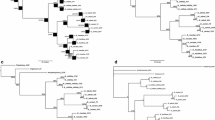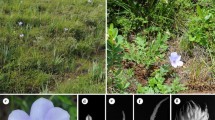Abstract
The precise delimitation of Taxaceae and Cephalotaxaceae is not totally resolved. Some contradicting taxonomic proposals have been published, which demonstrates the difficulties in establishing a natural classification of the families and especially in proposing a relevant treatment within the genera Taxus and Cephalotaxus. The aims of this study are to contribute to the phylogeny and specific delineation of the two conifer families on the basis of molecular data. A cladistic analysis of the sequences of five chloroplast (matK, rbcL, trnL, trnL-trnF spacer, and psbA-trnH spacer) and one nuclear (ITS) molecular markers was carried out, both individually and in combination, by distance, parsimony, likelihood, and Bayesian methods. The results confirm that the two families are monophyletic. In the genus Taxus, T. floridana is the first-branching taxon; T. brevifolia and T. globosa cluster together and are sister to T. baccata; the endemic T. yunnanensis clusters with T. wallichiana in subclade B and is only distantly related with the other four Taxus species in China (subclade A); T. fuana is closer to T. baccata than to other Taxus species. Torreya jackii and A. formosana are the first-branching species within Torreya and Amentotaxus, respectively. C. koreana and C. wilsoniana could be treated as two varieties of C. harringtonia. The ancestral distribution area of Taxaceae and Cephalotaxaceae is restricted either to Southwest China or Southeast China by DIVA analysis. The relaxed molecular clock indicates that the deepest divergences in Taxus go back to the late-Cretaceous. psbA-trnH, rbcL third codon position, and matK first codon position contributed most to the separation of taxa in Discriminant function analysis. Our results confirm, on a basis of multiple molecular markers and a complete sampling of basic species, the suggested monophyly of Taxaceae and Cephalotaxaceae and propose interspecific relationships within each group, with profound nomenclatural and taxonomic implications. Combination of partitioned Bayesian analysis and likelihood-based methods produced a more robust phylogenetic hypothesis for the two studied families.





Similar content being viewed by others
References
Barker FK, Lutzoni FM (2002) The utility of the incongruence length difference test. Syst Biol 51:625–637
Cheng Y, Nicolson RG, Tripp K, Chaw SM (2000) Phylogeny of Taxaceae and Cephalotaxaceae genera inferred from chloroplast matK gene and nuclear rDNA ITS region. Molec Phylogenet Evol 14:353–365
Collins D, Mill RR, Möller M (2003) Species separation of Taxus baccata, T. canadensis, and T. cuspidata (Taxaceae) and origins of their reputed hybrids inferred from RAPD and cpDNA data. Amer J Bot 90:175–182
Cope EA (1998) Taxaceae: the genera and cultivated species. Bot Rev 64:291–322
de Laubenfels DJ (1988) Coniferales. In: Flora Malesiana, series I, vol 10. Kluwer, Dordrecht, pp 337–453
Drummond AJ, Ho SYW, Phillips MJ, Rambaut A (2006) Relaxed phylogenetics and dating with confidence. PLoS Biol 4:e88
Farjon A (1998) World checklist and bibliography of conifers. Royal Botanical Gardens Kew. Richmond, UK
Fu L (1992) (ed.) China Plant Red Data Book: Rare and endangered plants. Science Press. Beijing, China and New York, USA
Fu L, Li N, Mill RR (1999) Sections of Cephalotaxaceae and Pinaceae. In: Wu Z, Raven PH (eds) Flora of China, vol 4. Science Press, Beijing. St. Louis, Missouri Botanical Garden
Gao LM, Möller M, Zhang XM, Hollingsworth ML, Liu J, Mill RR, Gibby M, Li DZ (2007) High variation and strong phylogeographic pattern among cpDNA haplotypes in Taxus wallichiana (Taxaceae) in China and North Vietnam. Molec Ecol 16:4684–4698
Goldmann N (1993) Statistical tests of models of DNA substitution. J Molec Evol 36:369–463
Graham A (1999) Late Cretaceous and Cenozoic history of North American vegetation north of Mexico. Oxford University Press, New York
Hao da C, Huang B, Yang L (2008) Phylogenetic relationships of the genus Taxus inferred from chloroplast intergenic spacer and nuclear coding DNA. Biol Pharm Bull 31:260–265
Hart JA (1987) Acladistic analysis of conifers: Preliminary results. J Arnold Arbor 68:296–307
Hartzell H Jr (1991) The yew tree: a thousand whispers. Hulogosi, Eugene, Oregon
Hils MH (1993) Taxaceae. In: Flora of North America Editorial Committee (eds.) Flora of North America North of Mexico, vol 2. Oxford University Press
Hipp AL, Hall JC, Sytsma KJ (2004) Phylogenetic accuracy, congruence between data partitions, and performance of the ILD. Syst Biol 53:81–89
Johnson LA, Soltis DE (1995) Phylogenetic inference in Saxifragaceae sensu stricto and Gilia (Polemoniaceae) using matK sequences. Ann Missouri Bot Gard 82:149–175
Kass RE, Raftery AE (1995) Bayes factors. J Am Stat Assoc 90:773–795
Kress WJ, Wurdack KJ, Zimmer EA, Weigt LA, Janzen DH (2005) Use of DNA barcodes to identify flowering plants. Proc Natl Acad Sci USA 102:8369–8374
Kvaček Z, Rember WC (2000) Shared Miocene conifers of the Clarkia flora and Europe. Acta Univ Carolinae–Geologica 44:75–85
Li J, Davis CC, Tredici PD, Donoghue MJ (2001) Phylogeny and biogeography of Taxus (Taxaceae) inferred from sequences of the internal transcribed spacer region of nuclear ribosomal DNA. Harvard Pap Bot 6:267–274
Li N, Fu LK (1997) Notes on gymnosperms I. Taxonomic treatments of some Chinese conifers. Novon 7:261–264
Li X, Zheng B, Su Y, Wang T (2002) Cladistic Analysis of Sequences of Chloroplast rbcL Gene and trnL-trnF intergenic spacer in Taxaceae and related taxa. Acta Sci Nat Univ Sunyatseni 41:70–74
Luu NDT, Thomas PI, Kim CL (2004) Vietnam/Conifers of Vietnam. Darwin Initiative. ISBN 1 872291 64 3
McKenna MC (1983) Holoarctic land mass rearrangement, cosmic events, and Cenozoic terrestrial organisms. Ann Missouri Bot Gard 70:459–489
Meyer HW, Manchester SR (1997) The Oligocence Bridge Creek Flora of the John Day Formation. Calif Publ Geol Sci 141:1–195
Möller M, Gao LM, Mill RR, Li DZ, Hollingsworth ML, Gibby M (2007) Morphometric analysis of the Taxus wallichiana complex (Taxaceae) based on herbarium material. Bot J Linn Soc 155:307–335
Nathorst AG (1908) Palaeobotanische Mitteillungen. 7. Über Palyssya, Stachyotaxus und Paleotaxus. K Svenska Vetensk Akad Handl 8:1–16
Nazari V, Zakharov EV, Sperling FA (2007) Phylogeny, historical biogeography, and taxonomic ranking of Parnassiinae (Lepidoptera, Papilionidae) based on morphology and seven genes. Molec Phylogenet Evol 42:131–156
Page CN (1990) Coniferophytina. In: Kramer KU, Green PS (eds) The families and genera of vascular plants, vol 1. Pteridophytes and Gymnosperms, Springer Berlin, pp 279–361
Posada D (2006) ModelTest Server: a web-based tool for the statistical selection of models of nucleotide substitution online. Nucleic Acids Res 34 (Web Server issue): W700–W703
Price RA, Thomas J, Strauss SH, Gadek PA, Quinn CJ, Palmer JD (1993) Familial relationships of conifers from rbcL sequence data. Amer J Bot (Suppl) 80:172
Quinn CJ, Price RA, Gadek PA (2002) Familial concepts and relationships in the conifers based on rbcL and matK sequence comparisons. Kew Bull 57:513–531
Quintas-Cardama A, Kantarjian H, Garcia-Manero G, O’Brien S, Faderl S, Estrov Z, Giles F, Murgo A, Ladie N, Verstovsek S, Cortes J (2007) Phase I/II study of subcutaneous homoharringtonine in patients with chronic myeloid leukemia who have failed prior therapy. Cancer 109:248–255
Ram VJ, Kumari S (2001) Natural products of plant origin as anticancer agents. Drug News Perspect 14:465–482
Rambaut A, Drummond AJ (2004) Tracer v1.3, Available from http://beast.bio.ed.ac.uk/Tracer
Ran JH, Wei XX, Wang XQ (2006) Molecular phylogeny and biogeography of Picea (Pinaceae): implications for phylogeographical studies using cytoplasmic haplotypes. Molec Phylogenet Evol 41:405–419
Ronquist F. (1996) DIVA (dispersal–vicariance analysis) ver. 1.2. Computer program and manual available by http://www.ebc.uu.se/systzoo/research/diva/diva.html
Ronquist F (1997) Dispersal-vicariance analysis: a new approach to the quantification of historical biogeography. Syst Biol 46:195–203
Ronquist F, Huelsenbeck JP (2003) MrBayes 3: Bayesian phylogenetic inference under mixed models. Bioinformatics 19:1572–1574
Shaw J, Lickey EB, Beck JT, Farmer SB, Liu W, Miller J, Siripun KC, Winder CT, Schilling EE, Small RL (2005) The tortoise and the hare II: relative utility of 21 noncoding chloroplast DNA sequences for phylogenetic analysis. Amer J Bot 92:142–166
Singh H (1961) The life history and systematic position of Cephalotaxus drupaceae Sieb. et Zucc. Phytomorphology 11:153–197
Soltis DE, Soltis PS (1998) Choosing an approach and an appropriate gene for phylogenetic analysis. In: Soltis DE, Soltis PS, Doyle JJ (eds) Molecular systematics of plants II: DNA Sequencing. Kluwer, Boston, MA, pp 1–42
Spjut RW (2007) Taxonomy and nomenclature of Taxus. J Bot Res Inst Texas 23:203–289
Strauss SH, Doerksen AH, Byrne JR (1989) Evolutionary relationships of Douglas-fir and its relatives (genus Pseudotsuga) from DNA restriction fragment analysis. Canad J Bot 68:1502–1510
Swofford DL (2002) PAUP*. Phylogenetic Analysis Using Parsimony (*and Other Methods). Version 4. Sinauer Associates, Sunderland, Massachusetts
Taberlet P, Gielly L, Pautou G, Bouvet J (1991) Universal primers for amplification of three non-coding regions of chloroplast DNA. Pl Molec Biol 17:1105–1109
Tamura K, Dudley J, Nei M, Kumar S (2007) MEGA4: molecular evolutionary genetics analysis (MEGA) Software Version 4.0. Molec Biol Evol 24:1596–1599
Thompson JD, Higgins DG, Gibson TJ (1994) CLUSTAL W: improving the sensitivity of progressive multiple sequence alignment through sequence weighting, position-specific gap penalties and weight matrix choice. Nucleic Acids Res 22:4673–4680
Tiffney BH (1985) The Eocene North Atlantic Land Bridge: Its importance in Tertiary and modern phytogeography of the northern hemisphere. J Arnold Arbor 66:243–273
Tripp KE (1995) Cephalotaxus: the plum yews. Arnoldia 55:24–39
van Rozendaal EL, Kurstjens SJ, van Beek TA, van den Berg RG (1999) Chemotaxonomy of Taxus. Phytochemistry 52:427–433
van Rozendaal EL, Lelyveld GP, van Beek TA (2000) Screening of the needles of different yew species and cultivars for paclitaxel and related taxoids. Phytochemistry 53:383–389
Wang XQ, Shu YQ (2000) Chloroplast matK gene phylogeny of Taxaceae and Cephalotaxaceae, with additional reference to the systematic position of Nageia. Acta Phytotax Sin 38:201–210
Won H, Renner SS (2006) Dating dispersal and radiation in the gymnosperm Gnetum (Gnetales)–clock calibration when outgroup relationships are uncertain. Syst Biol 55:610–622
Zhang D, Dirr MA, Price RA (2000) Discrimination and genetic diversity of Cephalotaxus accessions using AFLP Markers. J Amer Soc Hort Sci 125:404–412
Zwickl DJ (2006) Genetic algorithm approaches for the phylogenetic analysis of large biological sequence datasets under the maximum likelihood criterion. Ph.D. dissertation, The University of Texas at Austin
Acknowledgments
We thank the following experts for providing the plant materials: YunFen Geng (YunNan Academy of Forestry, KunMing, China), Qing Wang (WuHan Botanical Garden, Chinese Academy of Sciences, China), YinKe Zhang (HangZhou Botanical Garden, ZheJiang, China), Li Xu (Chinese Academy of Tropical Agriculture, DanZhou, HaiNan, China), Yan Liu (GuangXi Institute of Botany, GuiLin, China), Christopher Quinn (Royal Botanic Garden, Sydney, Australia), Ron Determann (Atlanta Botanical Garden, USA), Didier Maerki (Arboretum de Villardebelle, France), Robert G. Nicolson (Smith College, USA), Duang Buddhasukh (Chiang Mai University, Thailand), Richard W. Spjut (World Botanical Associates, California, USA), Stephane Bailleul (Montreal Botanical Garden, Canada), Bob Ursem (Botanic Garden, Delft University of Technology, Netherland), and James Stevenson (University of Oxford Botanic Garden, UK). We are grateful to Richard W. Spjut for morphology confirmation of Taxus species and Alexei Drummond (University of Auckland, New Zealand) for suggestions in divergence time estimation. This study was supported by the National 973 Project (2007CB707802) of the Ministry of Science & Technology of China and the Innovation Fund of Drug R & D (2007E11SF0052) of Dalian Bureau of Science & Technology.
Author information
Authors and Affiliations
Corresponding author
Electronic supplementary material
Below is the link to the electronic supplementary material.
Rights and permissions
About this article
Cite this article
Hao, D.C., Xiao, P.G., Huang, B. et al. Interspecific relationships and origins of Taxaceae and Cephalotaxaceae revealed by partitioned Bayesian analyses of chloroplast and nuclear DNA sequences. Plant Syst Evol 276, 89–104 (2008). https://doi.org/10.1007/s00606-008-0069-0
Received:
Accepted:
Published:
Issue Date:
DOI: https://doi.org/10.1007/s00606-008-0069-0




